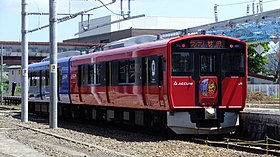
A battery electric multiple unit (BEMU), battery electric railcar or accumulator railcar is an electrically driven multiple unit or railcar whose energy is derived from rechargeable batteries driving the traction motors.
Prime advantages of these vehicles is that they do not use fossil fuels such as coal or diesel fuel, emit no exhaust gases and do not require the railway to have expensive infrastructure like electric ground rails or overhead catenary.[citation needed] On the down side is the weight of the batteries, which raises the vehicle weight, affecting the range before recharging of between 300 and 600 kilometres (186 and 373 mi). Currently, battery electric units have a higher purchase price and running costs than petrol or diesel railcars. One or more charging stations are required along the routes they operate, unless operation is on a mixture of electrified and unelectrified track, with the batteries being charged from the electrified track.[citation needed]
Battery technology has greatly improved over the past 20 years, broadening the scope of use of battery trains, moving away from limited niche applications. Vivarail in the United Kingdom claim their trains have a range of 100 miles (160 km) on only battery power, with a 10-minute charging time.[1] These sorts of ranges and battery recharging times greatly widens the scope of use of battery or battery-electric trains. Despite higher purchase, on certain railway lines battery trains are economically viable as the very high cost and maintenance of full line electrification is eliminated. Previously, incorporating lightly used unelectrified lines into an electrified network meant extending expensive electrical infrastructure, making many extensions unviable. Modern battery-electric trains have the ability to operate on both types of track. A number of metro networks around the world have extended electrified metro lines using battery-electric technology, with a number of networks considering the option.
From March 2014, passenger battery trains have been in operation in Japan on a number of lines. Austria has overhead wire/battery trains which became operational in 2019.[2] Britain successfully trialled fare paying passenger hybrid overhead wire/lithium battery trains in January and February 2015.[3]
According to a 2019 analysis by VDE e.V., on a line run more frequently than approximately every 24 to 30 minutes, BEMU is more expensive than electrifying the line and running standard EMUs; for lines run less frequently than this threshold, BEMU is cheaper.[4]
- ^ "Battery trains and decarbonisation of the national network". 8 Jul 2020. Archived from the original on 9 Jul 2020.
- ^ "Powering the trains of tomorrow". 26 January 2017.
- ^ "New Network Rail train runs on rechargeable batteries". 14 January 2015.
- ^ Alternativen zu Dieseltriebzügen im SPNV